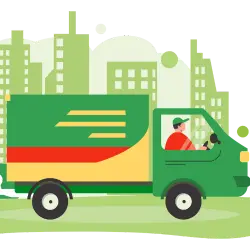Three-fourths of America’s tonnage is shipped via the trucking industry, employing millions and generating $732.3 billion in gross freight revenues. [1]American Trucking Associations. “Economics and Industry Data“. Accessed May 18, 2022. If you want to start a trucking business, one of the most significant challenges involves obtaining the correct licenses and permits. Industry-specific permits to carry freight throughout the United States are required. Applying for an MC number and trucking authority are two of the first steps you need to take if you plan to have your trucking company operate across state borders. In this guide, we explore the ins and outs of obtaining MC numbers and trucking authority in ten simple steps!
What Is Trucking Authority?

Suppose you want to transport goods throughout the United States. In that case, you will likely need trucking authority, a granted permission by the Federal Motor Carriers Safety Administration (FMCSA) to transport cargo throughout the United States. While there are some exemptions, you will likely need trucking authority if you want to run a large freight company or employ other drivers to provide interstate services.
There are different types of authorities for various purposes. For example, freight forwarders require different authority than motor carriers. While obtaining trucking authority can be a headache for novice and veteran business owners alike, it gives you the opportunity to make more money.

What is operating authority?
If you work in the trucking industry, you have probably heard the term “operating authority” or “motor carrier authority”. These terms are interchangeable with trucking authority.
What Is an MC Number?
A Motor Carrier Number (MC Number) is a number that motor carriers receive from the FMCSA upon the granting of trucking authority. This number is proof that you have permission to transport goods, as outlined by your specific authority.

What is a DOT number?
Another important regulatory number you need if you want to run a trucking business is a USDOT Number. This number is regulated by the United States Department of Transportation (USDOT). This tracking number helps freight forwarders and regulators understand more about your business. It will monitor your safety records, vehicle classifications, and other core details.
What Are the Different Types of Authority?
Unfortunately, there are many types of authority that you must understand before you begin the application process. There are three primary types of authority: motor carriers, freight forwarders, and brokers.[2]Cottingham & Butler. “Authority Types: Motor Carrier, Freight Forwarder, Broker“. Accessed May 18, 2022.
Let’s explore these authorities in more detail below:
Motor carrier
A motor carrier is a business that transports goods like cargo, food, cars, etc. This can also refer to a business that transports passengers. You must have MC authority to provide various types of cargo services.

Freight forwarder
A freight forwarder is a transportation-related business that helps organize freight for shipping. This may involve combining various cargo loads for shipment, transporting cargo from a pickup point to a place of shipment, or providing multiple other shipping-related services. In many cases, a motor carrier will be a subcontractor of a freight forwarder.[3]Kennedys. “When a Property Broker is Really a Forwarder“. Accessed May 18, 2022.
Broker
A broker is an individual or business that negotiates with motor carriers to transport goods. A broker is not the party responsible for the transportation of the cargo.

Contract vs. common carriers
Another critical factor to understand before you begin operating is the difference between common carriers and contract carriers.
Contract carriers must have a contract with the businesses they work with. On the other hand, common carriers can transport cargo for anyone that is willing to pay them as long as it complies with federal regulations. Common carriers can work with the general public, while contract carriers will need fixed contractors with specific entities.[4]U.S. Department of Transportation. “Cargo Liability Study”. Accessed November 16, 2023..
While both of these carriers will need liability insurance to operate legally, common carriers will also need cargo insurance to comply with regulations.
Benefits of Having Your Own Trucking Authority

In many cases, individuals or businesses applying for trucking authority have previous experience in the trucking industry. There are many benefits associated with having your own trucking authority. Let’s explore the primary advantages below:
- Autonomy: It will give you the power to choose your own loads, hire your own drivers, and more.
- Interstate Travel: Trucking authority allows you to operate through multiple states.
- Profit: Having trucking authority allows you to expand your revenue streams and keep more of your income.
- Flexibility: You can choose which jobs to take or refuse and have more control over the routes you take.
While there’s no doubt about the many upsides associated with applying for your authority, you must remember that it requires more responsibility. Running a trucking company can be difficult, and you must be prepared to seek your own work, hire employees, and follow federal and local guidelines.
How to Get Trucking Authority in 10 Steps
Now that you understand the differences between authorities, it’s time to start the application process. Take a look below for ten simple steps you need to take to obtain authority:

Step 1: Register your trucking company
Before you can apply for an MC number, you need to register your company, and each state has its own registration requirements and costs. You should also determine if you want to start a sole proprietorship, LLC, or any other type of business structure.
Step 2: Get your Employer Identification Number (EIN)
Now it’s time to obtain an employer identification number (EIN). This is an identification number provided to business entities by the Internal Revenue Service (IRS).
Keep in mind, that you will not need an EIN if you decide to start a sole proprietorship. However, you can still apply for one if you don’t want to conduct business under your social security number (SSN).

Step 3: Register your business with the Department of Transportation (USDOT)
Next, it’s time to apply for a DOT Number from the US Department of Transportation. This will help the USDOT, freight forwarders, and other entities find information on your vehicles, safety record, and more.
Unfortunately, you will need to renew this number every two years to maintain DOT authority. Also, if you change your business name or any other core details, this will require updating.
Step 4: Apply for your motor carrier (MC) number
Now, it’s time to apply for your MC number. You must have this to provide a wide range of cargo services, including being involved in any type of interstate trade. You can file for this number on the FMCSA website.

Step 5: Get trucking authority insurance and file for a BOC-3
Once you apply for your MC number with FMCSA, you need to file a BOC-3 and obtain an insurance policy. This must be completed within 20 days of applying for your MC Number.
If you don’t apply for a BOC-3 or obtain a relevant insurance policy, you won’t gain your authority.
Step 6: Pay the Heavy Vehicle Use Tax (HVUT)
Once your insurance and BOC-3 are in place, you need to pay your Heavy Vehicle Use Tax (HVUT). HVUT is a tax payable by heavy vehicles using USA highways, and this is another cost associated with running a trucking company with motor carrier authority.

Step 7: Set up your IRP (International Registration Plan)
If you plan on running a trucking company that operates throughout multiple jurisdictions, you need to register at IRP. It will require the following details:
- Title Information
- VIN
- Purchase Cost
- Purchase Date
- Make
- Model
- States You’re Planning to Operate Within
Step 8: Set up an International Fuel Tax Agreement (IFTA) account
Now, it’s time to set up an IFTA account. This allows you to report your fuel use taxes within the 48 mainland USA states and various Canadian provinces, and you must report these at the end of every fiscal quarter.
This report will include the number of miles driven in each jurisdiction and details regarding all fuel purchases.

Step 9: Complete your UCR (Unified Carrier Registration)
Next, obtain a UCR permit. This will verify that you have the correct insurance policies in the states that you’re trading in. You will need to register in each state that you operate in. This will come with a fee, which is dependent on the size of your current fleet.
You will need to re-apply for this each year.
Step 10: Enroll in a drug and alcohol testing program
Finally, you need to register with a drug and alcohol testing program. Your truck drivers must be able to pass negative drug screens for federal regulations. Drivers must be registered with a drug and alcohol testing facility.
MC and DOT Number Costs
The cost of an MC and DOT number is relatively affordable, given the opportunities these licenses can afford your business. Let’s look at the FMCSA fees for authority below:
- Permanent Authority: $300
- Notice of Name Change: $14
- Reinstate Authority: $80
You do not need to pay a separate fee for a USDOT number.
Trucking Authority & MC Number FAQs
We receive many questions about trucking authority and MC numbers. Let’s take a look at some of the most popular questions and their answers below:
How much does it cost to get your own authority?
Obtaining authority typically costs $300, which is payable to the FMCSA.[5]FMCSA. “Get Authority to Operate (MC Number)“. Accessed May 18, 2022. There are also other costs, such as insurance, which you will need to factor in which will depend on the type of business you’re running and the type of authority you need to obtain.
How long does it take to get a DOT number?
In many cases, you can obtain a DOT in under an hour. However, this does not provide you with authority. It takes weeks to receive your MC Number.
What is the difference between a DOT and an MC Number?
A DOT Number is primarily a tracking number (or ID number) that hosts core details about your business, its fleet, and your safety record. This is regulated by the US Department of Transportation (USDOT).
On the other hand, an MC Number provides you with the authority to conduct business. An MC Number is needed for companies that are operating across state borders.
Is trucking authority hard to maintain?
As long as you comply with local and federal regulations, you should not have issues maintaining your operating authority.
Can I check the status of my application?
You can check the status of your application on the FMCSA website. However, you should receive a letter within a few days of your authority being granted.
Which types of carriers don’t need trucking authority?
Many trucking companies that only operate in a single state do not need authority. However, there are three other types of trucks that don’t need authority:
- Carriers that only transport cargo for themselves, also known as private carriers.
- A carrier that transports commodities that don’t have federal restrictions.
- Carriers that work within specific “commercial zones” that don’t have restrictions. This might occur when a city or region crosses multiple state boundaries.
Can I get a DOT number without insurance?
While you can apply for a DOT number without insurance, you won’t be able to operate with authority until the FMCSA sees proof of your BOC-3 and insurance policy.
Can I get my own authority and DOT number without a truck?
While you can apply for authority and a DOT number without a truck, you won’t be able to gain authority until you have a truck. This is because you need the correct insurance policies before your authority becomes active, and you need a truck to obtain an insurance policy.
Final Thoughts on Getting Your Trucking Authority and MC Number
Now that you understand how to obtain trucking authority, MC numbers, and other licenses that you need to start a trucking business, it’s time to decide if it’s the correct path for you. While obtaining operating authority can help you scale your business, it does come with added costs. Make sure you’re prepared with commercial truck financing to get you started today.






